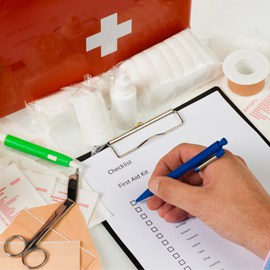Minimally invasive surgical procedures make it possible for patients to return home earlier after weight loss surgery. While the smaller wound reduces your risk of infection and allows you to leave the hospital faster, this puts more of the responsibility of caring for your wound in your hands.
Dr. Taylor will give you precise instructions on how best to care for your wounds after weight loss surgery, and you should always use those instructions as your first line of information. This guide is not a replacement to those instructions, but instead is intended to supplement those guidelines for added support as you care for your surgical weight loss wound.

What to Expect
The number, size and length of your wounds will depend on the type of weight loss surgery.
A bruise might develop around your wound during the first few days after weight loss surgery. This is normal and is not a cause for concern. Also, the skin around your wound may become red or discolored.
Fluids are going to seep out of the wound and cause the dressings to become dirty and damp. The fluid should be clear or white. If discolored fluids or puffiness appear at the wound site, contact Dr. Taylor immediately—these are signs that an infection may be forming. To prevent infection, you must keep the dressing at the wound site fresh and dry as your body begins to heal.
Pay close attention to your wound as you replace the dressing to make sure signs of infection are not present. Abnormal signs to be wary of include:
- Increased redness
- Additional pain associated with the wound site
- Severe swelling
- Bleeding
- Darkness in the wound
- Dried tissue around the wound
- Drainage of yellow, thick and bad-smelling fluids
If any of these symptoms develop, or if the wound becomes larger or deeper than before, contact Dr. Taylor. The wound will be sealed with Steri-Strips that lend support to the wound as it heals. Steri-Strips should be left on until they fall off or Dr. Taylor asks you to remove them.
Treating the Incision Wound
Once you return home from the hospital the task of replacing the bandages will fall to you. Dr. Taylor will inform you how often he recommends changing the bandages. Some patients are permitted to change the bandages daily. You should change the wound dressing if it becomes dirty or wet, even if it is not yet time for a new bandage. You will need to leave the dressing on the wound for 3 days.
To remove old dressing, carefully loosen the tape until it pulls away from the body. Always discard old dressings in a sealed plastic bag to prevent contamination, and wash your hands before touching the new dressing.
When caring for your wound, keep these tips in mind:
- Do not use any lotions or body wash while your wound is recovering
- Do not use antibacterial soaps or other chemicals as they can damage the tissue surrounding the wound
- Do not poke, probe or scratch at the incision site
- Do not peel the Steri-Strips off unless directed to do so by Dr. Taylor. You will need to wait for them to fall off, which can take up to three weeks.
Drainage from the wound should subside within three to five days after surgery. Dr. Taylor will assess the healing of your wound in a follow up visit seven to 10 days following weight loss surgery.
Suggested Reading
Long-Term Success with Weight Loss
Eating and Exercise Behavioral Changes to Lose Weight
Eating in Restaurants After Weight Loss Surgery
Also In This Section
- Fall for an Indoor Weight Loss Workout
- Healthy at Home
- A World of Weight Loss
- The Skills of Weight Loss Success
- Beat the Heat with Summer Fitness Tips
- The Importance of Water to Weight Loss
- Tips for Exercise after Bariatric Surgery
- Which Medications Should You Avoid After Bariatric Surgery?
- 4 Tips for Quick Weight Loss
- Driving Habits and Obesity

